Isotope Research Group
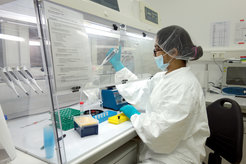
The Isotope Research group in the Department of Archaeology is committed to applying stable isotope methods within multidisciplinary research programmes that are focused on human palaeoclimates, palaeoenvironments, palaeodiets and palaeomobility. The laboratory facilities support the diverse projects of PhD students, postdoctoral researchers, and visiting scholars, ranging from the adaptations of early Homo sapiens and its hominin relatives to the causes of Pleistocene and Holocene megafaunal extinctions, and from the migration history and modern ecology of wildebeest in East Africa to the social and environmental impacts early rice agriculture in Asia.
The group works on applying bulk isotopic methodologies to archaeological materials, including bones, teeth, sediments, and charred plant material, within the framework of contextualized, well-informed archaeological questions. It also studies single compound biomarkers linked to past human environments and activities, including plant wax biomarkers and fire biomarkers. Alongside novel archaeological applications, the group is also committed to the production of foundational modern baseline research to track variability in different ecological contexts. These baselines can then be used to help understand isotopic results from the past.
Isotope Research Group Projects
Biomolecular history of South Asia
Project members: Ayushi Nayak, Patrick Roberts, Nicole Boivin, Michael Petraglia
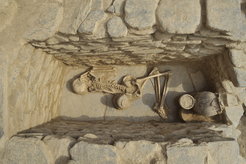
South Asia is, and has long been, a region of tremendous environmental and cultural diversity. The region is home to numerous languages belonging to several major language families, as well as diverse religious, ethnic and subsistence groups. These diverse groups occupy a broad range of ecological zones, from arid deserts to mountains, plains and tropical forests. How this tremendous diversity was created is a question that has challenged a range of disciplines.
This project seeks to open a new window onto South Asia’s past through the application of biomolecular methods, including isotope analysis and investigations of ancient dental samples. These methods hold great potential for providing new insights into South Asian prehistory, in particular concerning major cultural transitions and their link to changes in human mobility, diet and population composition.
Late Pleistocene-to-Holocene Ecological Change and High-Altitude Human Adaptations in Lesotho, Southern Africa
Project members: Robert Patalano, Patrick Roberts
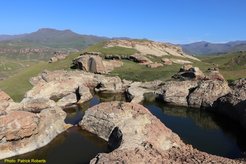
Investigation of Homo sapiens’ early expansions into high altitude African environments is changing how we perceive our species’ adaptions to various ‘extreme’ Pleistocene climates and habitats. Given the historic emphasis placed on sequences from Southern African archaeological sites at or near the coast, it is now crucial to complement such studies with those from the continent’s topographically variable and biologically diverse interior.
This project seeks to open a new window into Lesotho’s high-altitude settings through the application of compound-specific plant wax biomarkers, mainly normal (n-) alkanes and n-alkanoic acids. The use of wax biomarkers in upland archaeological sites of Lesotho offers opportunities to study past distributions of C3 and C4 vegetation and the impact of changes in temperature and precipitation on plant and animal resources from about 60,000 years ago into the present.
Because these high-altitude settings were susceptible to climate change, cold and dry conditions, and patchy resource distributions, the archaeology and paleoecology of Lesotho provide important perspectives regarding major adaptive challenges humans faced, as well as population interactions along the Maloti-Drakensberg mountain range.
Reconstruction of Climate, Vegetation and Fire Across Palaeolithic Transitions in the Indian Subcontinent
Project members: Deepak Jha, Patrick Roberts, Michael Petraglia
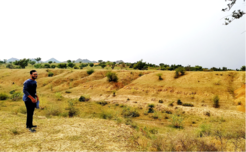
The Indian subcontinent occupies a key geographic location at the southern mid-point of Asia. With respect to human evolutionary studies, the subcontinent deserves consideration as a critical area for exploring hominin dispersal processes, particularly the migration of Homo sapiens during the Late Pleistocene. During the Middle and Late Pleistocene, there is emerging archaeological evidence for major technological transitions, changes in cultural adaptations, and varying settlement and subsistence patterns. Unfortunately, the climatic and environmental contexts of these cultural shifts remain poorly understood.
This project will seek to obtain novel information about the environments that hominins were occupying in India, allowing us to examine technological and behavioural changes. A range of multi-proxy palaeoenvironmental analyses will be conducted, including bulk isotopic analysis of soil organic matter (δ13C and δ15N values), compound-specific isotopic analysis (δ13C and δD values) of extracted leaf waxes, and soil carbonate isotopic analysis (δ13C and δ18O values). Palaeofire activities will be investigated using the extraction of macroscopic charcoal particles and polycyclic aromatic hydrocarbons (PAHs) from sediments collected from the archaeological sites preserved in different parts of the Indian subcontinent.
Isotope Analysis and Middle and Upper Palaeolithic Hunting in Germany
Project members: Phoebe Heddell-Stevens
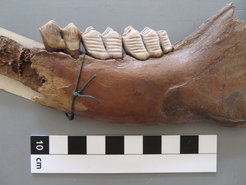
The behaviour of large herbivores has long played a major role in shaping the lifeways of those hominin groups who hunted them. While a vast body of research exists on the subsistence strategies of Middle and Upper Palaeolithic hunter-gatherers in Europe, there is a critical lack of direct evidence for the palaeoecology of key prey-species at a local level, or on timescales applicable to those of human activity. This research project seeks to address that gap through the application of stable isotope analysis to faunal remains from archaeological sites.
This involves multiple stable isotope analysis (δ13C, δ18O and 87Sr/86Sr) of sequentially sampled large herbivore tooth enamel to reconstruct diet, range and migration patterns of different species in Germany. Analysis of sequentially sampled enamel provides higher resolution data at sub-annual timescales relating directly to the period of human activity at a site. This data is then used to gain deeper insight into the subsistence behaviour of the hominins that exploited these animals, contributing to ongoing debates around hominin adaptive flexibility in the context of Late Pleistocene in western Europe and beyond.
Assessing the environmental context of Middle Palaeolithic (M.P.) – Late Palaeolithic (L.P.) transition in South Asia
Project members: Gopesh Jha, Patrick Roberts, Michael Petraglia
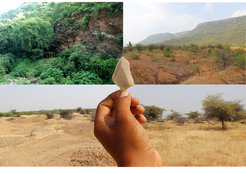
Evolutionary changes are often driven by fluctuating and unstable environments, triggering behavioral flexibility. Hominin adaptations were undoubtedly shaped by climate change and landscape-scale shifts in ecological resources. Nevertheless, they are rarely investigated, especially in a South Asian context, despite it sitting at a crucial geographical junction with major east to west human migration routes across Asia, and showing signs of significant changes in human demography and technological behaviour during the Middle and Late Pleistocene. Particularly notable in this regard is the expansion of our own species into the region during this period.
Recent studies have demonstrated that several regions of South Asia experienced technological transition during Late Pleistocene. It has been argued that arid conditions of MIS 4 and MIS 3 were a driving factor behind the MP technological diversification and emergence of microlith techno-complexes in South Asia, suggesting that the transition occurred convergently and may have emerged in-situ from its antecedent technology (i.e., Middle Paleolithic). However, existing studies lack associated paleoenvironmental data, restricting the verification as to whether climate change was truly influencing past behaviour.
The current project assesses the environmental context of M.P.- L.P. transition in the Cuddapah basin with the aim to relate observations of climate variability to the nature and timing of Late Pleistocene human innovation. We are employing a multi-proxy environmental approach (leaf-wax biomarkers, compound-specific Isotope: δ¹³C and δD, bulk δ¹³C and δ¹8O) and combining the obtained data with techno-cultural data to explore the relationship between climatic and environmental fluctuations and technological shifts.
Non-Adult Palaeopathology and Nutrition in pre-Roman Italy
Project members: Giulia Riccomi, Patrick Roberts, Mary Lucas

In Europe, palaeopathological analyses of scurvy (vitamin C deficiency) predominantly corroborates its presence during the post-medieval period, in association with the burials of sailors, soldiers, or famine victims. By contrast, scant sources of this disease are offered for other historical periods. This project focuses on reconstructing health conditions and dietary profiles in Pontecagnano, one of the best archaeologically-documented pre-Roman sites in Italy. The palaeopathological analysis of an Etruscan-period (720-580 BCE) skeletal sample of non-adults reveals the presence of typical scorbutic lesions (e.g. diffuse porosities of the skull, endocranial lesions and periosteal new bone formation on pelvis and long bones) which fit with a diagnosis of scurvy.
This project aims to combine skeletal palaeopathology and biochemistry of bone and tooth tissue in order to reconstruct early life-histories of individuals with and without palaeopathological indicators. The dietary profile of these individuals will be investigated by incremental dentine sampling for stable carbon and nitrogen isotope analysis, bulk bone collagen for stable carbon and nitrogen isotope analysis, and stable carbon and oxygen isotope analysis of tooth enamel bioapatite. The generated life history data will be used to extend our knowledge about the prevalence of scurvy in archaeological populations in Mediterranean Europe, potentially offering important insights into childhood conditions and nutrition, as well as into human health and metabolic disease as a whole.
Osteology, biomolecular analysis and identity in Medieval Spain
Project Members: Patxi Pérez Ramallo, Jana Ilgner, Mary Lucas, Ricardo Fernandes, Erin Scott, Patrick Roberts,
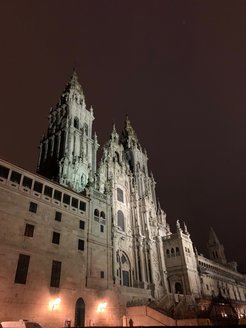
Between the 9th and the 15th centuries CE, the Iberian Peninsula was at the forefront of the religious, economic, and political changes sweeping across Europe during the Medieval Period. This included the expansion of Christianity following the disintegration of the Umayyad Caliphate. A growth in religious infrastructure driven by Christian territorial expansion into Al-Andalus, the former Islamic states in modern Spain and Portugal, and the emerging importance of the Camino de Santiago (the Way of St. James) from the 11th century CE, represented critical processes in changing urban networks and social stratification. From this time onwards, northern Iberia witnessed marked demographic and economic change due to the emergence and development of different Christian Kingdoms. Urban centres formed where the three main monotheistic religions - Judaism, Islam and Christianity - coexisted, exchanging periods of peace with social tension until the Christian expulsion of the Jewish and Islamic communities at the end of the Middle Ages.
The legacy of the major shifts occurring in Iberia during the Middle Ages can still be felt in the region today. By combining osteological analysis, multiple stable isotope analysis, and aDNA, this project aims to reproduce and investigate the medieval societies of the Iberian Peninsula throughout these centuries. The project will contrast novel data with existing historical datasets and explore parts of society often neglected in archival records. Research is particularly focused on pilgrims and societies related to the Camino de Santiago, analysing warrior monks or crusaders, and studying Islamic minorities within emergent Christian kingdoms. The project seeks to develop a better understanding of the social changes relevant to the formation of Christian identity, including the ‘Reconquista’ ideology used to justify the territorial expansion of the Iberian Christian Kingdoms following Umayyad rule (711 CE).







